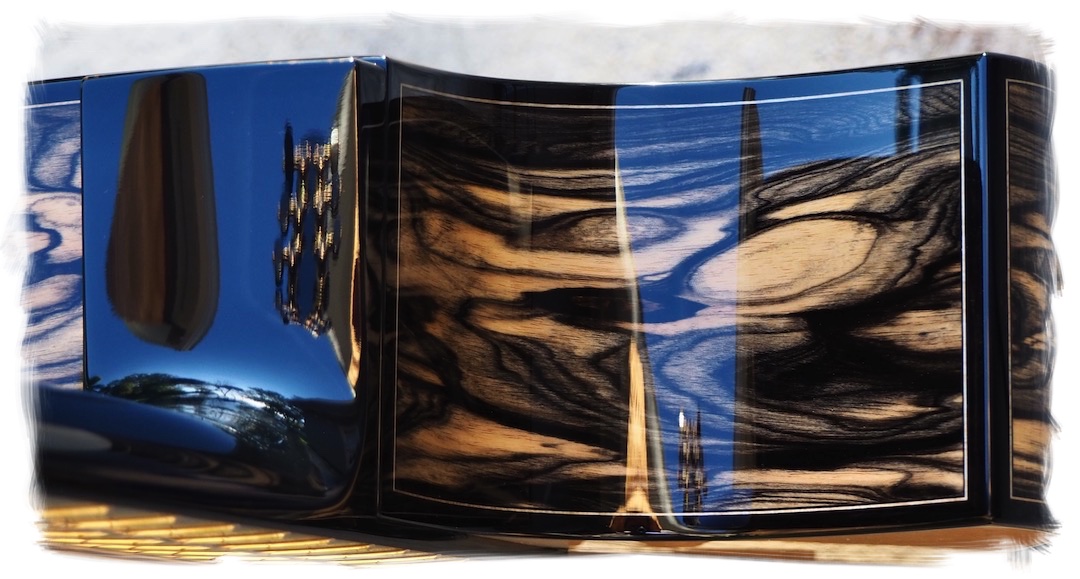Fay Guitars
Simon Fay Guitars

MY THOUGHTS ON GUITAR FINISH
After extensive experimentation with many different finish materials, I have settled on a urethane finish because I believe it is currently the best finish available for steel string guitars. I do all my own finish work and produce a remarkably thin finish of exceptional quality that rivals French Polish for tone.
For most of my building career (2008-2020), I outsourced my finish work to a talented (now retired) finisher who did an outstanding polyester finish for me. Over the years, I've had several customers request a French Polish on the soundboard and I could not help but notice the tonal improvement this finish brought to my guitars. It is commonly cited that a thin finish is very important for guitar tone but my experience is that the finish type also has a noticeable effect as well.
Finish characteristics that are important to luthiers:
Repairability
Durability (Dent, Scratch, and Solvent Resistance)
Flexibility (Cold checking)
Longevity
Appearance
Tactile Feel
Effect on Tone
The major players here are shellac, nitrocellulose lacquer, oil varnish, conversion varnish, polyester, and urethane. Almost all production guitars and guitars from premier small shops and well-regarded luthiers utilize one of these finish materials.
French Polish (Shellac)
I love shellac. Tonally, it is the standard against which all other finishes are measured. It has remarkable longevity and is truly an heirloom quality finish. It is a beautiful finish and imparts color depending on what type of shellac flakes are used. French Polish is a physically demanding and time consuming process that requires great skill to execute at a high level. It is quite challenging to produce a French Polish finish with a flawless mirror gloss like you would find on high-end guitars finished in lacquer. Personally, I enjoy the process but recognize it isn’t normally the best finish for some guitarists due to its delicate nature. One thing about shellac that many players may not be aware of is the wonderful tactile feel of the finish — French Polished necks feel incredible.
The biggest negative is that it is very delicate when new and some players will find that their perspiration quickly erodes the finish. It is easily scratched and offers little protection against marks and dents. If you own a French Polished guitar, it is helpful to have the mindset that you may need to have the guitar touched up every now and then.
Oil Varnish
A thin oil varnish rivals French Polish for tone. It is easy to buff to a mirror gloss, doesn’t cold check, and has much better solvent resistance than shellac or lacquer. Like shellac, varnish can last for a very long time and has an equally wonderful tactile feel. It is roughly equivalent to nitro in terms of dent and scratch resistance. Like most finishes, it has poor repairability. For the most part, I was extremely happy with my oil varnish results but struggled with drying issues over Rosewood and application issues (surface tension pulling the finish away from edges). I’m OCD about my work and I just wasn’t able to get the degree of perfection I desire in my finishes. However, the biggest issue for me was the noticeable amber cast the finish imparts to the guitar. Oil varnish looks absolutely spectacular over Mahogany but I didn’t particularly like how it looked over Spruce, Maple, and dark woods like Ebony.
Nitrocellulose Lacquer
Nitro is the traditional American guitar finish and is a hugely popular finishing material both among large manufacturers, small shops, and individual luthiers. Like shellac, it is easily repaired but also much less labor intensive. The finish is beautiful and it is relatively easy to apply a very thin finish. If applied nor more than 3 mils thick, lacquer will yield a finish that rivals both shellac and oil varnish in sound. The biggest negatives are that it scratches easily, cold checks, has very poor solvent resistance, can be damaged by the plasticizers in rubber materials, and begins to yellow and decay after several decades. It is quite common to see lacquer finish guitars develop soft, sticky necks and other finish issues within 5-10 years of ownership.
Polyester
Polyester is the finish of choice for a lot of large production manufacturers. Kevin Ryan and Jim Olson and a number of other luthiers use polyester finishes on their instruments. It is a two component finish that catalyzes via chemical or UV cure. Polyester has outstanding physical properties. It does not decay or yellow with time and does not check/fracture with rapid temperature changes. It is amazingly durable and has phenomenal scratch, dent, and solvent resistance. Even industrial strength paint strippers are ineffective on polyester finish. The tactile feel of a gloss material is excellent but not quite as “silky” as shellac or oil varnish. In my opinion, it is a superb choice for factory built guitars. The finish can be applied as a thin film but is typically applied as an overly thick film when used on low cost instruments.
I used polyester on my guitars for many years and absolutely loved the durability and appearance of the finish. My finish guy did a spectacular job and applied a thin 4 mil finish on the top. (If you are unfamiliar with the term, a mil simply refers to one thousandths of an inch and thus, a 4 mil finish is 0.004” thick.) Unfortunately, I always noticed a difference in the sound of my guitar pre and post finish — with the latter sounding more constrained and less open. It is important to understand that the skill with which the finish is applied is often more important than the finish type. For example, a thick French Polish finish would negatively affect tone. Nevertheless, a number of us in the lutherie community have come to the conclusion that no matter how thin it is applied, polyester will always lessen the tonal potential of a guitar.
Urethane
Urethane is a two component finish like polyester but it is a much softer and more flexible coating. It is just hard enough that it doesn’t get scratches from general handling the way that nitro, shellac, and varnish do. Urethane doesn’t cold check and it has excellent solvent resistance - only very strong chemicals can affect it. The tactile feel is superb and equally as nice as varnish and shellac. Longevity is also excellent and the finish doesn’t degrade or yellow over time. Repairability is similar to varnish and polyester. Aesthetically, urethane is my favorite finish due to its remarkable clarity that magnifies grain and causes woods to burst with color and shimmer under light. And most importantly, an ultra-thin urethane finish (3 mils or less) is similar to shellac in what it does for tone - or to be more specific, what it doesn't do to the tone. My guitars pre-finish and post-finish sound almost identical with a 3 mil urethane finish.
Closing Thoughts
For ultra-thin soundboard finishes (3 mils or under): shellac, varnish, nitro, and urethane all become low percentage variables that have very little effect on tone. At this level, the finish is thin enough that a guitar pre and post finish will sound nearly identical. For the absolute best tone, one of these finish materials at this coating thickness is what you want on your guitar top. Unfortunately, only French Polish is universally applied as a super thin coating. Oil varnish is often applied quite thin as well but it is quite rare in the guitar making industry. In the hands of a skilled finisher, nitrocellulose lacquer can be applied as a 3 mil coating but it almost never is. Instead, lacquer finishes typically hover around 5 to 8 mils (or even thicker with sunburst finishes) — about the same thickness as urethane and polyester. Urethane and polyester are relatively easy to apply in the 5 to 8 mil range but become insanely difficult to apply as a 3 mil coating.
Despite the challenges of applying an ultra-thin urethane finish, I've found the results to absolutely be worth the effort. In the context of a responsive steel string guitar, I believe urethane stands high above the competition. Urethane offers great protection and durability and has none of the common ownership frustrations of nitrocellulose lacquer guitars. The finish doesn't limit the tonal potential of my guitars and it is a beautiful and easy to care for coating.
I’d also like to take the time to discuss two popular myths regarding nitrocellulose lacquer.
No other finish lets the wood breathe like nitro.
First of all, finishes don’t breathe nor is nitrocellulose similar to the cellulose in wood. Nitrocellulose is in the same chemical family as nitroglycerin and TNT. It is far removed from the cellulose in wood and is highly explosive and flammable in high concentrations. The most natural of all the finish resins would be shellac which is refined from secretions from the female lac bug. Modern oil varnishes are usually made with phenolic or urethane resin and are no more natural than nitro, polyester, or urethane. Homemade oil varnishes used on violins are quite different from the varnish used on guitars or furniture and use naturally occurring components such as amber, copal, shellac, sandarac, mastic, and linseed oil. Chemically, all of these finishes try to accomplish the same thing — deposit a protective resin over the wood that prevent moisture, dirt, and chemicals from entering the wood as well as provide durability. None of the finishes used on guitars allows them to “breathe”.
When looking at finishes, it is important to understand that whether the resin is man-made or naturally occurring — they are all just polymers (either thermoset or thermoplastic). Synthetic resins have the added property of being able to be manipulated to achieve a wide range of physical characteristics and this is a huge advantage for finish materials and why modern finish coatings can be tailored to have specialized characteristics for specific industries (marine, indoor, outdoor, musical instruments, etc.)
Poly finishes look like plastic and don’t sound as good as lacquer.
The modern poly finishes (urethane and polyester) are often touted as being thick, less attractive finishes that don’t let the wood vibrate like a good nitrocellulose lacquer finish. The reality is that this statement is typically only true when directed at entry-level, mass-produced guitars. However, any of the top-tier guitar manufacturers like Martin (nitro), Taylor (polyester), and Larrivee (urethane) produce reasonably thin finishes on their guitars. Tonally, I'd choose nitro or urethane over polyester but neither of these finishes offer the kind of bulletproof durability that polyester provides.
Regarding appearances, all three finish materials look very similar. I don't think there is a person alive that could identify whether a finish is lacquer, urethane, or polyester just by looking at it. Subtle differences would be noticeable if you applied the coatings adjacently on a piece of wood but even then, most folks would have difficulty telling them apart. Oil varnish and shellac are more readily distinguished but that is mostly on account of the color those materials impart to the surface. All of these finish materials can produce beautiful results when they are combined with a good sealer and pore filler that pops the grain and brings out the wood's color.

© 2023 Simon Fay Guitars